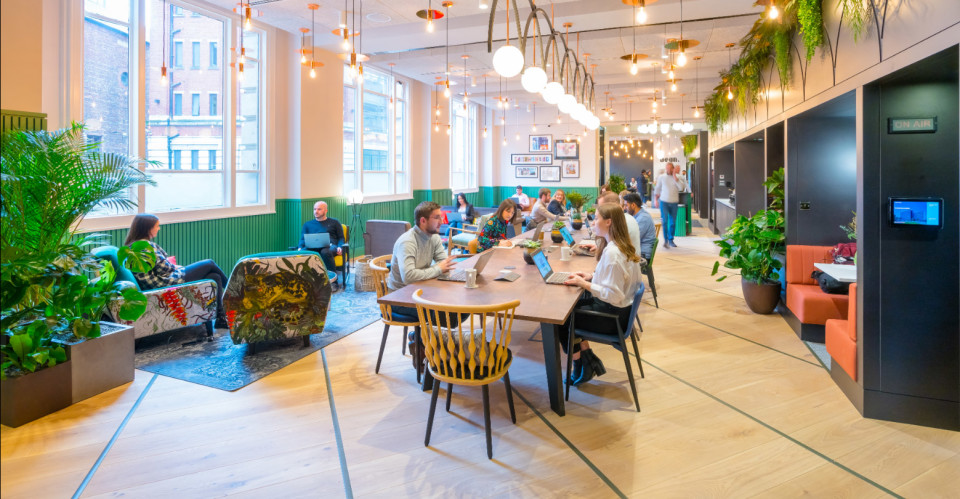Bruntwood Works' A to Z of Commercial Property Terms
By Bruntwood

New to office searching? We know how difficult it can be to understand property speak and we know workspace comes with quite a lot of its own terminology and jargon. That’s why Bruntwood Works is making it our mission to make things easy to understand for our customers. So, to make searching for an office that bit simpler, here’s our handy guide to cutting through all that pesky lingo!
Different types of office space
Virtual - perfect for both small, home businesses and larger, established businesses that want to show presence in a location where they do not have a staffed office.
Coworking - this space provides complete flexibility and low-cost office space, while allowing people to interact with a community of like-minded businesses. The options include a hot desk, shared office workspace or dedicated desk.
Serviced offices - a ‘plug and play’ fully equipped office that provides businesses with everything they need, incorporated into one monthly bill.
Leased offices - also referred to as a conventional or traditional office, it’s a whole office space that’s let to a business owner by a landlord for a particular amount of time.
Managed offices (Made & Managed) –a bridge between a serviced office and a leased office. They’re perfect for a business that wants someone to take away the hassle, resources and time in designing an office layout, but still wants to influence their own space.
All inclusive - combines rent, service charge, insurance and electricity into a single cost that remains fixed throughout your full term, with no hidden fees. Exclusive of business rates and reinstatement/ dilapidation charges.
Internet options for offices
Contended leased line internet - If your office has one of these, it means you’ll be sharing your internet line with other companies in the building.
Dedicated leased line internet - Unlike contended lease line internet, this will only be used by your office.
Office fitout
Category A (CAT A) – basic kitting out of a building or space - a ‘blank canvas’.
Category B (CAT B) – a finished office or space that your company can simply move into and start working.
Chilled beams - Usually hidden under the ‘suspended ceilings’ (see below), chilled beams are pipes of water which are used to chill or raise the temperature of a room.
DDA compliant - Standing for Disability Discrimination Act, this means there’s access for disabled users. Simple as that.
Dry risers - Pipes that are normally empty, but they can be connected to a pressurised water source by firefighters for a quick water supply in case of emergency.
Elevations - If anyone mentions the elevations of a property, they basically just mean a view of a building seen from one side.
HVAC – Heating, ventilation and air conditioning.
Raised access flooring - This pretty much does what it says on the tin as a structural floor is elevated above a solid base. Usually this method is used to hide cables.
Suspended ceilings - Basically an upside-down version of raised floors, these are additional lightweight ceilings which are hung on wires from the main ceiling to hide any sneaky wires, pipes and vents.
Three part perimeter trunking - These are the plastic rails you might see running around the walls of an office. Inside these rails are three separate cases used to pass cables around the room, again just making things that bit tidier.
Contract and legal terms for offices
B1 use – Every property has an approved planning use, the code for office use is B1.
Break clause - If you, or your landlord, want to end the lease early, this is where a break clause would come in, allowing you to do just that. There’ll be a ‘break date’ part way through your lease, which is the date when you should give notice that you want to leave early.
Demise – the space occupied by a tenant, under the lease contract.
Dilapidations – repairs that are needed at the beginning or end of a tenancy or lease.
Efficient floor plates - A term used to describe how efficiently a floor can be used as office space.
Headline rent - The amount of rent you will pay after any concessionary or rent-free periods have ended.
Heads of Terms - This outlines the main legal requirements of the customer and the supplier, and associated costs, but it’s not legally binding.
Lease agreement - A contract between a landlord and customer that usually covers a long period of time.
Licence agreement - A shorter lease, generally signed for a period of up to 12 months.
Service charge - thi is a customer’s contribution to the maintenance and upkeep of the building, and usually includes the heating of your office.
Term certain – a lease with a defined beginning and end.
Wayleave - If you want any work carried out on the property by an outside company, then a wayleave will need to be granted by your landlord before these can take place. Essentially, it’s just permission for the works to go ahead.
If you need to know more or something isn’t clear, you can always get in touch with our customer service team who will be happy to answer your questions.
Stay Connected!
Sign up to our newsletter for the latest news, updates and offers.